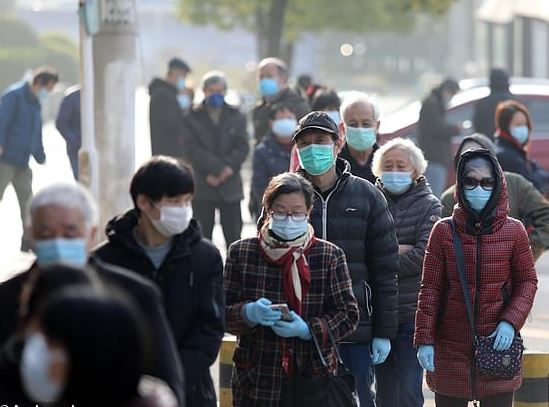Up to 14 per cent of the recovered coronavirus patients in china have tested positive again, medical experts have revealed.
Research showed about three to 14 per cent of the former patients were diagnosed with the virus once more after being given the all-clear.
The news came as experts feared that China is facing a second outbreak due to the increasing number of imported cases as well as the ‘silent carriers’ who show no symptoms.
Millions of residents of Hubei, the former centre of the pandemic, can now leave the province after officials lifted a two-month draconian lockdown.
Up to 14 per cent of the recovered coronavirus patients have tested positive later, Chinese medical experts have revealed. People line up to get nuclei tests in Wuhan
Meanwhile, 14 per cent of those who recovered were diagnosed with the pathogen later in southern China’s Guangdong Province, said Song Tie, deputy director of the provincial Centre for Disease Control and Prevention.
In the study conducted by the Wuhan medics, the recovered patients showed no symptoms after testing positive again. But the researchers found no evidence that they became infectious after recovery as their family members all tested negative.
Guangdong officials also suggested the people in close contact with such recovered patients weren’t infected by them.
Medical experts have raised questions about if nucleic acid tests are reliable in detecting traces of the virus in some of the recovered patients.
‘It’s possible that these recovered patients tested negative before because of false results,’ Mr Wang added. ‘The accuracy of a nucleic acid test is 30 to 50 per cent.’
The chief doctor said it was crucial to closely monitor recovered patients and put them under two-week quarantine after discharge.
‘Our sample size for this study was relatively small,’ said the hospital director. ‘We are planning to carry out large-scale research among local communities in Wuhan soon.’
About three to 14 per cent of the former patients are diagnosed with the deadly disease again after being discharged from hospitals. The picture shows a 98-year-old recovered patient being discharged from the Leishenshan Hospital in Wuhan
According to classified Chinese government data seen by the South China Morning Post , the true scale and of the hidden number of these ‘silent carriers’ could be higher than first thought. Medics cheer themselves up before going into an ICU ward at the Red Cross Hospital in Wuhan
Other reports suggested that the number of people infected with coronavirus who show no or delayed symptoms could be as high as one-third of those who test positive for the disease.
According to classified Chinese government data seen by the south china morning post, the true scale and of the hidden number of these ‘silent carriers’ could be higher than first thought.
It said by the end of February more than 43,000 people had tested positive for coronavirus in China without showing symptoms and were quarantined but not counted in official figures, which stood at 80,000 at the time.
Other reports suggested that the number of people infected with coronavirus who show no or delayed symptoms could be as high as one-third of those who test positive for the disease. Medical workers are pictured treating a coronavirus patient at a hospital in Wuhan
This discovery has huge ramifications for the strategies being used by countries to contain the virus.
Scientists are currently unable to agree on what role asymptomatic transmission plays in spreading the disease and how infectious people with no symptoms are.
China had discharged 74,051 patients – over 90 per cent of its infected cases – from hospitals as of yesterday, according to official statistics.
Globally, over 430,000 people are infected with the deadly disease and nearly 20,000 people have died.


















